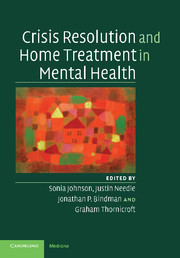Book contents
- Frontmatter
- Contents
- List of contributors
- Foreword
- Acknowledgements
- Section 1 Introduction and concepts
- Section 2 The evidence
- 4 The classic home treatment studies
- 5 Recent research on crisis resolution teams: findings and limitations
- Section 3 Current practice
- Section 4 Variations and enhancements
- Section 5 Developing a local service
- Index
- References
5 - Recent research on crisis resolution teams: findings and limitations
from Section 2 - The evidence
Published online by Cambridge University Press: 13 August 2009
- Frontmatter
- Contents
- List of contributors
- Foreword
- Acknowledgements
- Section 1 Introduction and concepts
- Section 2 The evidence
- 4 The classic home treatment studies
- 5 Recent research on crisis resolution teams: findings and limitations
- Section 3 Current practice
- Section 4 Variations and enhancements
- Section 5 Developing a local service
- Index
- References
Summary
The introduction of a government policy mandating that crisis resolution teams (CRTs) be established throughout England (Department of Health, 2000) provoked considerable dissent about whether enough research evidence supporting these teams was available to justify this requirement. This was exemplified by a heated debate in the British Medical Journal (Pelosi and Jackson, 2000; Smyth and Hoult, 2000; and subsequent correspondence), in which the evidence presented in favour of CRTs was described in one contribution as ‘overwhelming’ (Bracken et al., 2000) and in another as a ‘tired (and tiresome) polemic masquerading as science’ (Burns, 2000). A respected commentator on community mental healthcare (Holloway, 2000) wrote:
Despite its attractions, out-of-hours home-based crisis intervention is logically a rather poor choice for mainstream purchasers and providers, given the chronic and recurrent nature of severe mental illness. The evidence base in its favour is not strong, even against the poor quality forms of ‘standard care’ available 20 years ago or more.
As discussed in Chapter 4, dissimilarities between current clinical populations and service contexts and those involved in the classic home treatment studies are indeed a major problem in accepting these studies as satisfactory evidence. However, while the literature on the CRT model remains limited compared with other currently favoured mental health service models such as assertive outreach and early intervention, new research evaluations with greater relevance to the current context are slowly beginning to accumulate in the new millennium. This chapter will describe these recent studies.
- Type
- Chapter
- Information
- Crisis Resolution and Home Treatment in Mental Health , pp. 51 - 64Publisher: Cambridge University PressPrint publication year: 2008
References
- 4
- Cited by



